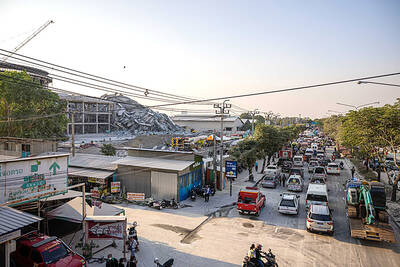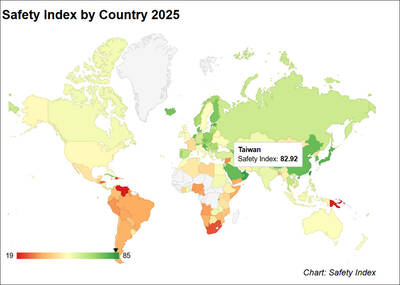After laboring 15 years on a tea farm, Zong Qinghou returned to the city and a job riding his bicycle around town selling flavored ice pops. It was an early experiment in private enterprise at the elementary school where his mother worked, and he and his two employees hoped to grow it into a successful company.
Twenty years later, his humble enterprise is China's largest beverage company, Wahaha, with a nationally known brand name and revenues of US$1.3 billion last year. Zong has become one of the most influential entrepreneurs in China and his company's Future Cola has just been shipped to the US.
"Don't worry," he said in an interview at his company's headquarters. "We're not going to bring down Coke and Pepsi."
Not in the US market at least. Not yet.
Zong's hands are full battling cola wars on his own turf. While striving to improve Future Cola's third-place position in the competitive domestic market, he's looking beyond the carbonated beverage market, which he believes is "past its peak" in China and the world. Cola has been in China for nearly a century -- Coca-Cola established its brand in the 1930s and 1940s, then re-entered the market in 1979 as the communist regime liberalized trade.
Today, juices and health drinks are an emerging and fast-growing trend.
"Chinese people are even more fashionable than Westerners," he said. "We love the new and loathe the old."
`Egg striking a rock'
When Wahaha, a Chinese word used to mimic the sound of a laughing child, launched Future Cola six years ago, analysts didn't give it much hope. Several domestic companies had tried selling cola and failed. Coke and Pepsi have cachet because they are American brands.
"Our intention of competing with Coke and Pepsi was regarded as an egg striking a rock," Zong admitted.
Wahaha spent a year developing its own cola, producing a beverage that tastes closer to Pepsi than Coke, Zong said. They named it fei chang cola, which means extraordinary or unusual. (Its sound is similar to "future.") Packaged in red, with a font very similar to that of Coke's, its appeal is a patriotic one.
But in the prosperous big cities, the idea of a "national cola" has not been a winning one. Coke had 24 percent of the soda market last year while Future Cola has less than half that, according to Chinese media reports. Coke sells 2.2 million tonnes per year, Pepsi 1.3 million tonnes and Future Cola 662,000 tonnes, according to the Economic Daily.
"The motivation of buying Chinese cola because of patriotism is rather limiting," said Qu Yongxiang, an analyst with Guotai Jun'an Securities. "If Coke and Pepsi were Japanese, this appeal might work better."
Hometown loyalty doesn't get it very far either. Wahaha is the second-largest taxpayer in Zhejiang Province, after a tobacco company, but the main concession stand at the airport in Hangzhou, the provincial capital, carries not a single Wahaha product. That contract was won by Coke.
"Coke has a better reputation," explains a sales girl. "And it tastes better."
When a customer points out that Future Cola is made in Hangzhou, the sales girl replies: "But Coke is made in Hangzhou, too!"
Future Cola dominates in places where a few pennies can make a difference -- that is, in small cities, the poor interior and China's vast countryside. Rural consumers care more about price than brand.
"To people in central and western China, because Future Cola is the first in the market, it is perceived as an authentic cola product," said a report in the Economic Observer. "On average, the cost of a bottle of Future Cola is 0.5 yuan (US$0.06) lower than the two other colas, giving it great market advantage."
Growing competition
But the competition is about to stiffen as Coke expands into rural markets and Future Cola goes after urban ones. Wahaha has stepped up advertising in big cities while Coke has distributed refrigerators with its logo and promoted a bottle refund program in rural areas.
Coca-Cola did not respond to several requests for comment.
Zong said he does not intend to advertise in the US or actively promote Future Cola. He will leave that to its distributor, tiny Manpolo International Trading Co, a small import/export firm based in New York's Chinatown. More than 14,000 cases of Future Cola will initially be sold in New York and Los Angeles and, using the patriotic appeal, target the overseas Chinese population.
Like many of China's large enterprises, Wahaha's ownership structure is murky. The company calls itself a "mixed ownership" company, part joint venture, part joint-stock, part state-owned. In 1996, French food giant Danone invested in five joint-ventures with Wahaha, injecting more than US$70 million into the company. Wahaha was able to upgrade its equipment and expand production.
Now 59, Zong's official title is general manager and chairman of the board, but everyone knows he's the only boss who counts. He tastes every new product and works 16-hour days.
In the face of ever fiercer competition, Wahaha is undertaking its first restructuring in 17 years to re-tool its employee incentive system.
Qu said the Chinese cola market is not yet saturated, but there is not much more room for it to grow. He described cola as being at a stage of "stable development" rather than "explosive development." Fruit drinks and dairy drinks will grow much faster, at a rate of about 30 percent annually, he said.
"Fruit and dairy drinks are comprising a larger and larger portion in the overall food structure in daily life," he said. "That's the trend in big and developed cities."
Fruit king
Coke has a juice drink called "Coo," but so far, no nationwide brand of fruit drink has emerged. Qu said it's possible for Wahaha, already the No. 2 seller of bottled water in China, to take that role.
Zong, who has only a junior high school education, admires Bill Gates, a Harvard dropout, and Li Ka-shing (
"Experts have done analysis and found that highly educated people aren't fit to be entrepreneurs," he said. "If you know too much, you might hesitate and not take a chance.

AIR SUPPORT: The Ministry of National Defense thanked the US for the delivery, adding that it was an indicator of the White House’s commitment to the Taiwan Relations Act Deputy Minister of National Defense Po Horng-huei (柏鴻輝) and Representative to the US Alexander Yui on Friday attended a delivery ceremony for the first of Taiwan’s long-awaited 66 F-16C/D Block 70 jets at a Lockheed Martin Corp factory in Greenville, South Carolina. “We are so proud to be the global home of the F-16 and to support Taiwan’s air defense capabilities,” US Representative William Timmons wrote on X, alongside a photograph of Taiwanese and US officials at the event. The F-16C/D Block 70 jets Taiwan ordered have the same capabilities as aircraft that had been upgraded to F-16Vs. The batch of Lockheed Martin

GRIDLOCK: The National Fire Agency’s Special Search and Rescue team is on standby to travel to the countries to help out with the rescue effort A powerful earthquake rocked Myanmar and neighboring Thailand yesterday, killing at least three people in Bangkok and burying dozens when a high-rise building under construction collapsed. Footage shared on social media from Myanmar’s second-largest city showed widespread destruction, raising fears that many were trapped under the rubble or killed. The magnitude 7.7 earthquake, with an epicenter near Mandalay in Myanmar, struck at midday and was followed by a strong magnitude 6.4 aftershock. The extent of death, injury and destruction — especially in Myanmar, which is embroiled in a civil war and where information is tightly controlled at the best of times —

Taiwan was ranked the fourth-safest country in the world with a score of 82.9, trailing only Andorra, the United Arab Emirates and Qatar in Numbeo’s Safety Index by Country report. Taiwan’s score improved by 0.1 points compared with last year’s mid-year report, which had Taiwan fourth with a score of 82.8. However, both scores were lower than in last year’s first review, when Taiwan scored 83.3, and are a long way from when Taiwan was named the second-safest country in the world in 2021, scoring 84.8. Taiwan ranked higher than Singapore in ninth with a score of 77.4 and Japan in 10th with

SECURITY RISK: If there is a conflict between China and Taiwan, ‘there would likely be significant consequences to global economic and security interests,’ it said China remains the top military and cyber threat to the US and continues to make progress on capabilities to seize Taiwan, a report by US intelligence agencies said on Tuesday. The report provides an overview of the “collective insights” of top US intelligence agencies about the security threats to the US posed by foreign nations and criminal organizations. In its Annual Threat Assessment, the agencies divided threats facing the US into two broad categories, “nonstate transnational criminals and terrorists” and “major state actors,” with China, Russia, Iran and North Korea named. Of those countries, “China presents the most comprehensive and robust military threat